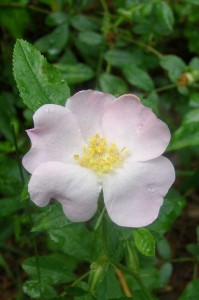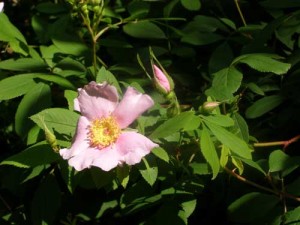A rose is a rose is a rose
By Ken Moore
Had Gertrude Stein explored the forested edges of Carrboro or the wet ditches of Mason Farm Biological Reserve, she may have composed something like, A rose is pink is pink is pink!
Of all the roses growing wild in North Carolina, only two of them are truly native, both beautiful shades of pink. Though fairly common, the Carolina rose, Rosa carolina, and the swamp rose, Rosa palustris, are not likely to be found in ordinary rose gardens. Sadly, in the wild their singular beauty is seldom noticed.
The diminutive Carolina rose grows throughout the eastern United States. You will find it along dry roadsides and forest edges. There is a colony of them along the woodland edge of the N.C. Botanical Garden’s new parking area. They have already flowered, but look for rose hips developing a bit later.
If you have a keen eye, you may spot Carolina rose still in flower along the inner path of the Frances Shetley Bikeway behind Carrboro Elementary School. Look for it; there’s a plant identification label there. Once established, this little rose forms a colony from underground runners. It prefers dry, sunny situations. In cultivation, it performs vigorously. I once had a plant that established itself as a lush 3-foot-high thicket, and the shiny dark-green foliage and thorny red stems always made me take a closer, admiring look.
To find the swamp rose, you’ll almost have to get your feet wet. Like the Carolina rose, it is common throughout the eastern U.S. Unlike its cousin, it prefers to have its feet in the water. There are some robust 7-foot-high shrubs in the Siler’s Bog ditches along the south loop of the Mason Farm pathway.
And there are a few plants along the moist woodland edge of the Shetley Bikeway wild garden.
If you enjoy paddling coastal rivers and swamps, you will most likely discover robust 6-foot-high swamp roses commonly growing in the water at the bases of big cypress trees. Red rose hips are a certain giveaway during late summer and fall.
In addition to habitat differences, there’s another way to distinguish the two.
The thorns of the Carolina rose are almost perfectly straight. Swamp rose thorns are curved downward.
Carolina rose flowers are even a bit smaller than the 2-inch flowers of the swamp rose.
Though these two wild roses grow naturally in different habitats, they both take easily to cultivation. Just remember to allow them freedom to roam a bit.
They are worth seeking out at native plant nurseries.
Now is the time of year for the flush of their flowering, though sometimes there may be an occasional flower or two later on.
The beauty of these two roses represents for me the image of a perfect rose. I can imagine Gertrude Stein being content with a pink rose is a pink rose is a pink rose.


Comments are closed.